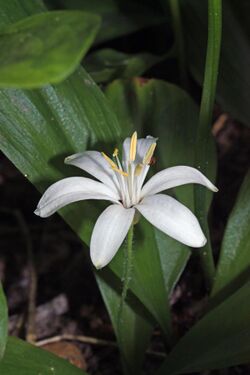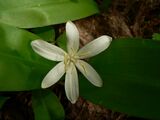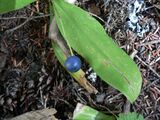Biology:Clintonia uniflora
| Clintonia uniflora | |
|---|---|

| |
| Mount Pilchuck State Park, July 2008 | |
| Scientific classification | |
| Kingdom: | Plantae |
| Clade: | Tracheophytes |
| Clade: | Angiosperms |
| Clade: | Monocots |
| Order: | Liliales |
| Family: | Liliaceae |
| Subfamily: | Lilioideae |
| Genus: | Clintonia |
| Species: | C. uniflora
|
| Binomial name | |
| Clintonia uniflora (Menzies ex Schult. & Schult. f.) Kunth
| |
| Synonyms[1] | |
| |
Clintonia uniflora, commonly known as bride's bonnet, queen's cup, or bead lily,[2][3][4] is a species of flowering plant in the lily family Liliaceae. The specific epithet uniflora means "one-flowered",[5] a characteristic that distinguishes this species from others in the genus Clintonia. For this reason, it is also known as the single-flowered clintonia.[6]
Description
Clintonia uniflora is a perennial herbaceous plant that spreads by means of underground rhizomes. It is the smallest plant in the genus, only 15 to 25 cm (6 to 10 in) tall. It has two or three leaves located at the base of a hairy stem. Each leaf is 2.5 to 6.5 cm (1 to 3 in) wide and 8 to 20 cm (3 to 8 in) long. A plant typically bears a single flower but occasionally there will be an inflorescence of two flowers. The small flower has six white tepals, each approximately 2 cm (0.8 in) long, and six protruding white stamens with pollen-dusted anthers. After pollination, the flower is replaced by a round blue berry approximately 1 cm (0.4 in) in diameter.[3]
The fruit is a single round blue berry up to a centimeter in diameter.
Taxonomy
In 1829, Josef August Schultes described the plant variety Smilacina borealis var. uniflora,[7] which was later segregated into species Smilacina uniflora. The latter was to become a synonym for Clintonia uniflora, first described by Carl Sigismund Kunth in 1850.[8]
Distribution
Clintonia uniflora is native to western North America, from southern Alaska to central California , extending eastward into southwestern Alberta and northwestern Montana.[1][3][9] It prefers cool montane coniferous forests, typically at elevations from 3,000 to 5,000 ft (914 to 1,524 m).[10]
C. uniflora occurs in many forest types but it prefers a cool moist coniferous forest consisting of western red cedar (Thuja plicata), western hemlock (Tsuga heterophylla), grand fir (Abies grandis), subalpine fir (Abies lasiocarpa), and Pacific silver fir (Abies amabilis). It is also associated with western white pine (Pinus monticola), Alaska cedar (Chamaecyparis nootkatensis), and noble fir (Abies procera). Companion species in the understory include threeleaf foamflower (Tiarella trifoliata), twinflower (Linnaea borealis), and Canadian bunchberry (Cornus canadensis).[10]
The range of C. uniflora overlaps with that of C. andrewsiana in Humboldt County and Del Norte County in northwestern California and Curry County in southwestern Oregon,[11][12] but the two species are readily distinguished by their overall size and their flowers. C. uniflora has a single flower with white tepals while C. andrewsiana has multiple flowers arranged in one or more umbels.[13] The tepals of the latter are a deep claret red.
Ecology
Clintonia uniflora is a perennial geophyte that can live up to 30 years (or more). The plant flowers between late May and July, and thereafter the fruit matures from late July to September.[3][10] Citizen scientists observe flowering plants uniformly throughout June and July.[14]
The plant is not considered palatable but it is of at least minor importance as food for some wildlife species including birds, elk, and deer. Frugivorous birds are the only reported dispersers of the seeds, which remain viable in the ground for at least a couple of years.[10]
Uses
The indigenous peoples of the Pacific Northwest, including the Nuxalk, the Cowlitz, and the Haisla peoples, used the plant as a dermatological aid and eye medicine. The Nlaka'pamux (also known as the Thompson people) mashed the ripe blue fruit and used it as a dye or stain. Today Clintonia uniflora is used as a garden ornamental.[10][15]
See also
- Bead lily
- Bluebead (disambiguation)
- List of plants known as lily
- Queen's Cup
References
- ↑ 1.0 1.1 "Clintonia uniflora (Menzies ex Schult. & Schult.f.) Kunth". Royal Botanic Gardens, Kew. https://powo.science.kew.org/taxon/urn:lsid:ipni.org:names:533180-1. Retrieved 18 August 2020.
- ↑ "Clintonia uniflora". Natural Resources Conservation Service PLANTS Database. USDA. https://plants.usda.gov/core/profile?symbol=CLUN2. Retrieved 18 August 2020.
- ↑ 3.0 3.1 3.2 3.3 Utech, Frederick H. (2002), "Clintonia uniflora", in Flora of North America Editorial Committee, Flora of North America North of Mexico (FNA), 26, New York and Oxford, http://www.efloras.org/florataxon.aspx?flora_id=1&taxon_id=242101531, retrieved 18 August 2020
- ↑ Slichter, Paul. "Clintonia uniflora". http://science.halleyhosting.com/nature/basin/3petal/lily/clintonia/queen.htm. Retrieved 22 August 2020.
- ↑ Stearn, W.T. (2004). Botanical Latin (4th (p/b) ed.). Portland, Oregon: Timber Press. ISBN 978-0-7153-1643-6.
- ↑ Painter, Elizabeth (May 1, 2016). "Common (vernacular) names applied to California vascular plants". https://ucjeps.berkeley.edu/cgi-bin/get_painter_common.pl?19854. Retrieved 16 October 2020.
- ↑ Schultes, J. A.; Schultes, J. H. (1829). "Smilacina borealis var. uniflora". Systema Vegetabilium 7 (1): 307. http://www.botanicus.org/page/734871. Retrieved 21 August 2020.
- ↑ Kunth, Karl Sigismund (1850). "C. uniflora". Enumeratio Plantarum Omnium Hucusque Cognitarum 5: 159. https://www.biodiversitylibrary.org/page/7425890#page/169/mode/1up. Retrieved 21 August 2020.
- ↑ " Clintonia uniflora", State-level distribution map from the North American Plant Atlas (NAPA) (Biota of North America Program (BONAP)), 2014, http://bonap.net/MapGallery/State/Clintonia%20uniflora.png, retrieved 18 August 2020
- ↑ 10.0 10.1 10.2 10.3 10.4 Meyer, Rachelle S. (2005). "Clintonia uniflora". U.S. Department of Agriculture, Forest Service, Rocky Mountain Research Station, Fire Sciences Laboratory. https://www.fs.fed.us/database/feis/plants/forb/cliuni/all.html. Retrieved 18 August 2020.
- ↑ " Clintonia uniflora", County-level distribution map from the North American Plant Atlas (NAPA) (Biota of North America Program (BONAP)), 2014, http://bonap.net/MapGallery/County/Clintonia%20uniflora.png, retrieved 18 August 2020
- ↑ " Clintonia andrewsiana", County-level distribution map from the North American Plant Atlas (NAPA) (Biota of North America Program (BONAP)), 2014, http://bonap.net/MapGallery/County/Clintonia%20andrewsiana.png, retrieved 4 August 2020
- ↑ McNeal, Dale W. (2012), "Clintonia uniflora", in Jepson Flora Project, Jepson eFlora, The Jepson Herbarium, University of California, Berkeley, http://ucjeps.berkeley.edu/eflora/eflora_display.php?tid=19854, retrieved 22 August 2020
- ↑ {{Inaturalist taxon}} template missing ID and not present in Wikidata.
- ↑ "Clintonia uniflora (Menzies ex J.A. & J.H. Schultes) Kunth". http://naeb.brit.org/uses/species/1033/. Retrieved 8 October 2020.
<ref> tag with name "NatureServe" defined in <references> is not used in prior text.Bibliography
- Moss, E. H. 1983. Flora of Alberta (ed. 2) i–xii, 1–687. University of Toronto Press, Toronto.
- Hultén, E. 1968. Flora of Alaska i–xxi, 1–1008. Stanford University Press, Stanford.
- Hitchcock, C. H., A.J. Cronquist, F. M. Ownbey & J. W. Thompson. 1969. Vascular Cryptogams, Gymnosperms, and Monocotyledons. 1: 1–914. In C. L. Hitchcock Vascular Plants of the Pacific Northwest. University of Washington Press, Seattle.
External links
| Wikimedia Commons has media related to: |
- "Photo gallery: Clintonia uniflora". Regents of the University of California, Berkeley. 2012. https://calphotos.berkeley.edu/cgi-bin/img_query?rel-taxon=begins+with&where-taxon=Clintonia+uniflora. Retrieved 22 August 2020.
- "Clintonia uniflora". University of Texas at Austin. https://www.wildflower.org/plants/result.php?id_plant=CLUN2. Retrieved 22 August 2020.
- "Queen's Cup (Clintonia uniflora)". plantwatch. https://www.naturewatch.ca/plantwatch/queens-cup/. Retrieved 16 October 2020.
Wikidata ☰ Q309753 entry
 |




